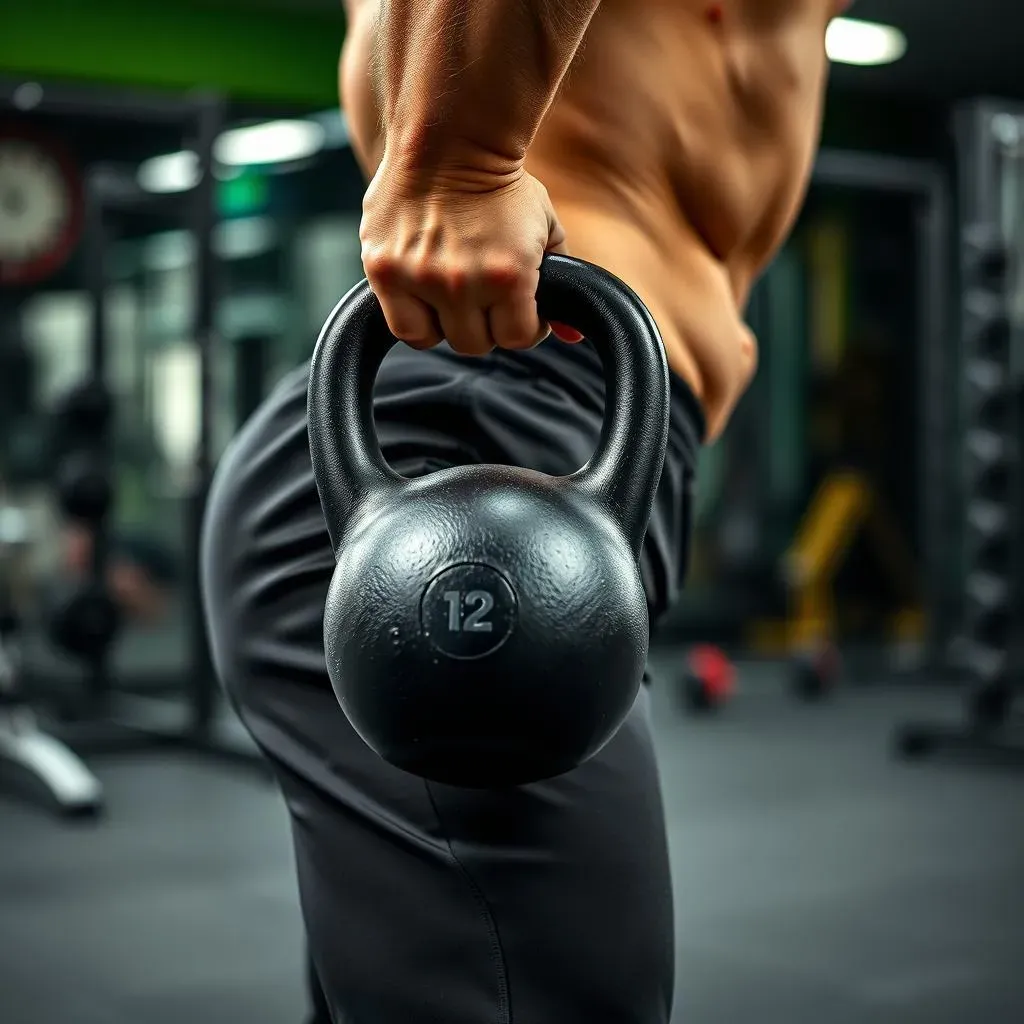Table of Contents
Ready to torch calories, build explosive strength, and sculpt a lean physique? Then it's time to embrace the power of the full body workout kettlebell swing. This isn't just another exercise; it's a dynamic movement that engages your entire body, from your glutes and hamstrings to your core and shoulders. Think of it as a one-stop shop for fitness, delivering a potent blend of strength, cardio, and mobility benefits.
Mastering the Kettlebell Swing: The Foundation of a Full Body Workout

Mastering the Kettlebell Swing: The Foundation of a Full Body Workout
The Hinge: Your Kettlebell Swing's Secret Weapon
Alright, let's dive into the heart of the kettlebell swing: the hinge. Forget squatting – this movement is all about hinging at your hips. Imagine you're closing a car door with your butt. Sounds weird, right? But that's the feeling you're going for! Keep your back straight (think proud chest), engage your core, and send your hips back, allowing the kettlebell to swing behind you.
The hinge isn't just about bending over; it's about loading your posterior chain – your glutes, hamstrings, and back muscles – like a coiled spring. This stored energy is what powers the swing, not your arms. Your arms are just along for the ride, guiding the kettlebell. Think of them as ropes attached to a pendulum. If you're feeling it in your lower back, you're probably squatting too much or not engaging your core properly.
Finding Your Stance: Setting Up for Success
Now that you've got the hinge down, let's talk stance. Stand with your feet shoulder-width apart, toes slightly pointed outwards. The kettlebell should be a few inches in front of you. Before you even pick it up, visualize the swing. Feel that hinge, engage your core, and get ready to explode.
When you pick up the kettlebell, hike it back between your legs, maintaining that hinge position. This is your starting point. From here, drive your hips forward, squeezing your glutes and exploding into a standing position. The kettlebell should float up to chest height, powered by your hips, not your arms. Then, let the kettlebell swing back down, hinging at your hips to absorb the momentum. Repeat.
Element | Description |
|---|---|
Stance | Feet shoulder-width apart, toes slightly outward |
Starting Position | Kettlebell a few inches in front, hiked back between legs |
Movement | Hinge at hips, drive forward with glutes, kettlebell to chest height |
Kettlebell Swing for Full Body Power: Muscles Worked and Benefits

Kettlebell Swing for Full Body Power: Muscles Worked and Benefits
Unlocking Full-Body Potential: More Than Just a Swing
so you've mastered the hinge and your stance is on point. Now, let's talk about why the kettlebell swing is such a powerhouse exercise. It's not just about swinging a weight back and forth; it's about engaging a symphony of muscles that work together to generate power and stability. We're talking about a true full-body experience here. From the tips of your toes to the top of your head, something is working.
The primary movers in the kettlebell swing are your posterior chain muscles: your glutes, hamstrings, and spinal erectors. These muscles are responsible for hip extension, which is the driving force behind the swing. But it doesn't stop there. Your core muscles – your abs, obliques, and lower back – work overtime to stabilize your spine and prevent injury. Your shoulders and arms act as guides, controlling the kettlebell's trajectory. Even your quads get in on the action, providing stability and power during the standing phase of the swing.
The Ripple Effect: Benefits Beyond the Burn
So, what do you get for all this hard work? A whole lot, actually. Beyond the obvious muscle building and calorie burning, kettlebell swings offer a range of benefits that extend to all aspects of your fitness. For starters, they're a fantastic way to improve your cardiovascular health. The dynamic nature of the swing elevates your heart rate, providing a killer cardio workout without the need for a treadmill or elliptical. Think of it as strength training meets cardio – a match made in fitness heaven.
But the benefits don't stop there. Kettlebell swings can also improve your posture, increase your power output, and enhance your athletic performance. The constant engagement of your core muscles strengthens your spine and promotes better alignment, while the explosive hip extension translates to improved power in other activities, like jumping, running, and lifting. Plus, they're just plain fun! There's something incredibly satisfying about swinging a heavy weight and feeling the power of your body in motion.
Benefit | Description |
|---|---|
Cardiovascular Health | Elevates heart rate, providing a cardio workout |
Posture Improvement | Strengthens core, promotes spinal alignment |
Power Output | Explosive hip extension translates to improved power |
Crafting Your Full Body Kettlebell Swing Workout Routine

Crafting Your Full Body Kettlebell Swing Workout Routine
Choosing Your Kettlebell Weight: Finding the Sweet Spot
Alright, so you're ready to dive into creating your own full body kettlebell swing routine. First things first, let's talk weight. Picking the right kettlebell weight is crucial. Too light, and you won't get the full benefit of the exercise. Too heavy, and you risk injury. It's a Goldilocks situation – you need to find that sweet spot. As a general rule, women can start with an 8kg or 12kg kettlebell, while men can begin with a 16kg or 20kg kettlebell. But remember, these are just starting points.
The best way to determine the right weight for you is to test it out. Can you perform 10-15 swings with good form? If so, you're probably in the right ballpark. If you're struggling to maintain your form, or if you're feeling pain in your lower back, drop down to a lighter weight. It's always better to start light and gradually increase the weight as you get stronger. Remember, it's not about ego lifting; it's about building strength and improving your fitness.
Also, you might need different weights for different exercises. For example, you might be able to swing a heavier kettlebell than you can clean and press. That's perfectly normal. Don't be afraid to experiment and find what works best for your body.
Designing Your Workout: Reps, Sets, and Rest
Now that you've got your kettlebell weight sorted out, let's talk about designing your workout. There are countless ways to incorporate kettlebell swings into a full body workout, but a simple and effective approach is to start with 3-4 sets of 10-15 swings, resting for 30-60 seconds between sets. As you get stronger, you can increase the number of sets, the number of reps, or the weight of the kettlebell.
To make your workout even more effective, consider pairing kettlebell swings with other exercises that target different muscle groups. For example, you could do a set of kettlebell swings followed by a set of push-ups, squats, or rows. This will not only work your entire body but also keep your heart rate elevated, maximizing the calorie burn. A sample workout routine might look like this:
- Kettlebell Swings: 3 sets of 15 reps
- Push-Ups: 3 sets of as many reps as possible
- Squats: 3 sets of 15 reps
- Rows: 3 sets of 12 reps
Listen to Your Body: The Key to Progress and Prevention
The most important thing to remember when crafting your full body kettlebell swing workout is to listen to your body. Pay attention to any pain or discomfort, and don't push yourself too hard, especially when you're just starting out. It's always better to err on the side of caution and gradually increase the intensity of your workouts as you get stronger. If you're feeling tired or sore, take a rest day. Overtraining can lead to injury and burnout, so it's important to find a balance between pushing yourself and allowing your body to recover.
Also, don't be afraid to modify the exercises to suit your fitness level. If you're struggling with the full kettlebell swing, you can start with a lighter weight or a modified version of the exercise, such as the two-handed kettlebell swing. As you get stronger, you can gradually progress to the full swing. The key is to be patient, consistent, and to listen to your body. With time and dedication, you'll be amazed at what you can achieve.
Advanced Kettlebell Swing Techniques for a Full Body Challenge

Advanced Kettlebell Swing Techniques for a Full Body Challenge
One-Arm Kettlebell Swings: Level Up Your Stability
Alright, you've mastered the two-handed swing – time to crank things up! One-arm kettlebell swings are where things get seriously interesting. This variation throws a wrench into your stability, forcing your core to work overtime to prevent rotation. It's like a built-in anti-rotation exercise disguised as a swing. You'll feel muscles you never knew you had firing up to keep you balanced and on track.
The key here is control. Start with a lighter weight than you'd typically use for two-handed swings. Focus on maintaining a straight line from your head to your heels, resisting the urge to twist or lean to one side. Engage your core, keep your shoulders square, and let your hips do the work. It's a humbling experience, but the payoff in terms of core strength and stability is huge.
The American Kettlebell Swing: Controversial Power
Now, let's talk about the American kettlebell swing. This variation involves swinging the kettlebell all the way overhead, rather than stopping at chest height. It's a bit of a controversial topic in the fitness world, with some experts arguing that it puts excessive stress on the shoulders and lower back. Others swear by it as a way to build explosive power and improve shoulder mobility.
Whether or not you choose to incorporate American kettlebell swings into your routine is a personal decision. If you do decide to try them, it's crucial to have excellent shoulder mobility and a strong core. Start with a lighter weight and focus on maintaining good form. Avoid hyperextending your back or shrugging your shoulders. If you experience any pain, stop immediately. There are plenty of other ways to challenge yourself without risking injury.
Technique | Description | Benefits | Cautions |
|---|---|---|---|
One-Arm Swing | Swing with one arm, focusing on core stability | Improved core strength, anti-rotation | Start light, maintain form |
American Swing | Swing overhead instead of to chest height | Explosive power, shoulder mobility (potentially) | Controversial, risk of injury, excellent form required |
Avoiding Pitfalls: Common Mistakes in the Full Body Kettlebell Swing Workout

Avoiding Pitfalls: Common Mistakes in the Full Body Kettlebell Swing Workout
Squatting Instead of Hinging: The Butt-Back Rule
One of the most common mistakes I see is people turning the kettlebell swing into a squat. Remember, it's a hinge, not a squat! Think about pushing your butt back like you're closing a car door with it. If your knees are bending excessively and your chest is dropping, you're squatting too much. This not only reduces the effectiveness of the exercise but also puts unnecessary stress on your knees and lower back. Keep that back straight, chest proud, and focus on the hip hinge.
Arming the Swing: It's All in the Hips
Another frequent error is using your arms to lift the kettlebell. Your arms should be relaxed, acting as guides, not primary movers. The power should come from your hips, not your shoulders. If you're feeling it in your shoulders more than your glutes and hamstrings, you're probably arming the swing. Focus on driving your hips forward explosively, squeezing your glutes at the top of the swing. Let the kettlebell float up naturally, powered by your hips.
Rounding the Back: Spinal Safety First
Rounding your back during the kettlebell swing is a recipe for disaster. It puts excessive stress on your spinal discs and can lead to serious injuries. Maintain a neutral spine throughout the entire movement, keeping your core engaged and your back straight. If you can't maintain a neutral spine, reduce the weight or modify the exercise. Your spinal health is paramount!
Mistake | Description | Solution |
|---|---|---|
Squatting | Bending knees excessively, dropping chest | Focus on hip hinge, push butt back |
Arming | Lifting kettlebell with arms, not hips | Relax arms, drive hips forward |
Rounding Back | Bending spine, disengaging core | Maintain neutral spine, engage core |
Conclusion: Swing Your Way to a Stronger, Fitter You
The full body workout kettlebell swing is more than just an exercise; it's a gateway to unlocking your athletic potential. By mastering the proper technique, understanding its benefits, and incorporating it strategically into your fitness routine, you can achieve remarkable results. Whether you're aiming to build strength, improve your cardiovascular health, or simply add a dynamic element to your workouts, the kettlebell swing offers a powerful and effective solution. So, pick up that kettlebell, embrace the swing, and embark on a journey to a stronger, fitter, and more powerful you. Remember to start slow, focus on form, and gradually increase the weight as you progress. The results will speak for themselves.